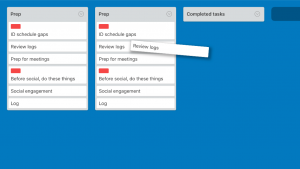“Captain’s log, stardate…” Can you picture Captain Kirk dictating his captain’s logs on the Enterprise? I sure can.
I’m the captain of my own life and career, and while the wind and seas are often stormy, I’m having a great time exploring.
For the past few years, off and on, I’ve been keeping a short log each day of the day’s activities. Just a few lines on what I did during the day. I’ve found that it helps keep things in context, helps me keep track loosely of how long I’ve been working on some things and how long it’s been since I worked on other things. It’s good for accountability and perspective.
I’ve gotten pretty good at logging at the end of the work day, but I’ve not been great at going back and reviewing those logs.
Tonight I went back over my entries so far this month with the following process, which I thought might be of use to you as well.
1. Make a plan
This right here is my plan; it is said, by the way, that one of the best ways to reduce stress about a situation is to write down a quick, if temporary, plan for dealing with it.
2. Read the past week or so’s entries
I ended up reading all this month’s.
3. Identify outstanding issues, ongoing challenges, highlights, and opportunities
The Institute for the Future says that it’s essential in this era of information overload to be able to effectively and efficiently extract actionable insights from the river of input flowing past us all the time.
4. Reflect
Intelligent action requires both knowledge and focused thought.
5. SSCC: Stop, Start, Continue, Change
Here’s the most important part. I took notes on all of the above, then I made a list of things, based on what I’d observed about my own activity, that I would like to stop, start, continue, and change.
6. Reread
I reread the entries again, there weren’t that many of them. “When we reflect on what we perceived during the journey, we receive a whole new level of information,” Sandra Ingerman once wrote.
7. Revise SSCC
In this case, I found that my particular observations in this case were easiest for me to understand when I put them in a specific order. So I wrote out a few sentences, based on my SSCC list.
8. Record your commitments
I put mine in Trello, as a repeatable checklist (drag to “done” column to mark done).
That’s my new process experiment – now I’m going to try to use this checklist each work day! I’ll be recording how it goes, of course.
